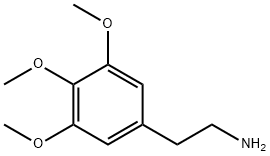Mescaline is one of the main active ingredients in the peyote
plant, Lophophora williamsii. It is also found in several other
cacti including the South American Trichocereus otherwise
known as the Peruvian torch species. Mescaline can also be
synthesized in the laboratory. It is one of the oldest known
hallucinogenic drugs. Ingestion of mescaline via use of the
peyote cactus has been used in rituals by North American
Indians dating back thousands of years. Ingestion of peyote
was also common among the Aztec, Apache, and Pima
Indians for religious, ceremonial, and medicinal purposes.
Mescaline was isolated from peyote in 1896 by the chemist
Hefter and in 1919, the chemical structure was confirmed by
Spath. There are many analogs of mescaline with over 250
being prepared and self-tested by the chemist and pharmacologist,
Alexander Shulgin (aka Sasha Shulgin). Mescaline
became a Schedule I drug and was placed in Controlled
Substances Act in 1970. Many of the related chemicals or
analogs of mescaline were also placed in Schedule I of the
Controlled Substances Act.
Mescaline is used recreationally as a hallucinogenic drug and it
is used in religious ceremonies for spiritual purposes by groups
such as the Native American church. Mescaline is purported not
to have any therapeutic benefits based on its Schedule I status.
When used recreationally typical doses range from 300 to
500 mg orally.
ChEBI: A phenethylamine alkaloid that is phenethylamine substituted at positions 3, 4 and 5 by methoxy groups.
Highly toxic by ingestion.
Poison by
intraperitoneal and intravenous routes.
Moderately toxic by ingestion route. An
experimental teratogen. Other experimental
reproductive effects. Human systemic
effects by intramuscular route: euphoria and
hallucinations, dstorted perceptions. A
psychotoimetic agent (a drug of abuse).
When heated to decomposition it emits
toxic fumes of NOx.
The primary exposure pathway is oral via ingestion of the
chemical powder or salt or via ingestion of peyote ‘ buttons.’
These buttons are the round, fleshy tops of the cactus that are
sliced and dried. Multiple buttons of peyote are typically
ingested due to the relatively small content (i.e., 40–50 mg) of
individual peyote buttons.
The exact mechanism of mescaline has not been clearly
defined. The central nervous system effects of mescaline appear
to involve stimulation of both serotonin and dopamine
receptors. In experimental studies, these effects can be blocked
by either serotonin antagonists such as methysergide or
dopamine antagonists such as haloperidol. Mescaline is structurally
related to the amphetamines and cathine and cathinone,
which are found in the plant Catha edulis. Mescaline is
a ring-substituted phenethylamine. Sympathomimetic effects
can occur and are thought to be centrally mediated. High doses
of peyote/mescaline can produce more pronounced sympathomimetic
effects such as tachycardia and hypertension.
Hallucinations may be associated with homicidal, suicidal, or
psychotic behaviors. There have been no reported deaths due to
the physiological effects of peyote/mescaline. Traumatic deaths
have occurred secondary to hallucinations. Mescaline does not
appear to inhibit monoamine oxidase.
